Russian missile 19 century
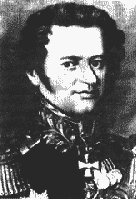 The story about the rocket technology of the XIX century should be started by mentioning the name of the outstanding Russian designer, organizer of production and combat use of the missiles, General Alexander Dmitrievich Zasyadko (1779-1837) [in the left portrait]. Interested in rocket business in 1814, he already three years later demonstrated at an artillery range in St. Petersburg combat missiles of his design, the range of which reached 2670 m. These missiles were made in a special pyrotechnic laboratory in Mogilev. In 1826, the works were moved to Petersburg, where a permanent rocket establishment was created for this purpose, capable of providing large-scale production of powder rockets.
The story about the rocket technology of the XIX century should be started by mentioning the name of the outstanding Russian designer, organizer of production and combat use of the missiles, General Alexander Dmitrievich Zasyadko (1779-1837) [in the left portrait]. Interested in rocket business in 1814, he already three years later demonstrated at an artillery range in St. Petersburg combat missiles of his design, the range of which reached 2670 m. These missiles were made in a special pyrotechnic laboratory in Mogilev. In 1826, the works were moved to Petersburg, where a permanent rocket establishment was created for this purpose, capable of providing large-scale production of powder rockets. Zasyadko is not only an outstanding designer of missiles, but also the founder of specialized military missile units, which have shown their effectiveness in many hostilities of the early 19th century. In the certification given to him by Field Marshal Barclay de Tolly, it was said: "During your time at your Main apartment for my testimony of experiments on the preparation and use of rockets in the army, I was happy to see your successful works and diligence in discovering such a new and useful tool."
On the initiative of Zasyadko in the Russian-Turkish war 1828-29. the production of combat missiles was established directly in the combat area. As a result of this, the 24 Company of the Second Army received about 10 thousands of caliber missiles from 6 to 36 pounds. (The linear caliber 106 mm was the latest to meet.) For their launch, the units had launchers that ensure simultaneous launch of missiles up to 36. These were the "ancestors" of the famous Guards mortars - "Katyush."
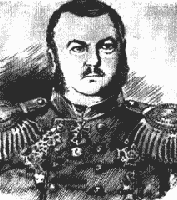 In March 1829, ships of the Danube military armed with rockets of the Zasyadko design flotilla. This marked the beginning of the introduction of missile weapons in the navy, which was facilitated by the "Note on the introduction of the use of military missiles in the navy." The author of the note was another prominent Russian missile of the time, Colonel (and soon general) Konstantin Ivanovich Konstantinov (1818-1871) [on the left]. He was undoubtedly one of the most striking figures in stories domestic rocket technology. In the above-mentioned “Note”, he pointed out: “Missiles that could have been useful when operating from rowing ships should not be less than four inches in diameter and two feet in length. They are supplied with brandkuhels or some other projectile with a filling of explosive or incendiary composition. " The launch tubes for these missiles were five feet long and allowed firing “leaving the rowers in their places”.
In March 1829, ships of the Danube military armed with rockets of the Zasyadko design flotilla. This marked the beginning of the introduction of missile weapons in the navy, which was facilitated by the "Note on the introduction of the use of military missiles in the navy." The author of the note was another prominent Russian missile of the time, Colonel (and soon general) Konstantin Ivanovich Konstantinov (1818-1871) [on the left]. He was undoubtedly one of the most striking figures in stories domestic rocket technology. In the above-mentioned “Note”, he pointed out: “Missiles that could have been useful when operating from rowing ships should not be less than four inches in diameter and two feet in length. They are supplied with brandkuhels or some other projectile with a filling of explosive or incendiary composition. " The launch tubes for these missiles were five feet long and allowed firing “leaving the rowers in their places”. It is noteworthy that the ship-launched missiles designed by Konstantinov were supplied with “lateral openings in such a direction so that the fire could erupt in the direction of the tangent to the rocket’s circumference; the purpose of this device is to inform the rocket during the flight of the rotational motion, from which it has both the correctness and greater range. ” At an elevation angle of the 45-55 ° launcher, these missiles initially had a range of over three kilometers. Konstantinov believed that "against the numerous fleet, under favorable conditions, the use of missiles could deliver some kind of success." The Chairman of the Marine Scientific Committee supported the initiative of Colonel Konstantinov and petitioned the General-Admiral (at that time, the highest naval official of the Russian Empire, to whom the Naval Ministry was subordinate) about the introduction of missiles on warships and coastal fortresses. As a result, the Russian Navy and Coast Guard were armed with incendiary, lighting and rescue missiles of calibers: 2, 2 1 / 2 and 4 inches with a range of up to four kilometers. “Three-pound, quarter-pound and half-pound grenades”, as well as “near and far shot” were used as warheads on them. Lighting rockets were supplied with parachutes. Rescue rockets were used to drop the ends (cables) from a ship in distress or onto it. In one of the estimated documents of the said department it is reported that a batch of 590 missiles was paid
Ruble 2034 46 3 / 4 penny.
Since January, 1851 began the formation of Russia's first naval missile training team. A year later, she was transferred to the jurisdiction of the Artillery Department of the Marine Ministry. This team was located in Kronstadt. The experienced rocket battery had eight launchers manufactured at the Kronstadt Marine Plant. The battery personnel included three officers, eight fireworks and thirty privates. The captain of the Marine Artillery Corps Mousselius was appointed the battery commander. Prior to that, he served in the St. Petersburg Rocket School, where he showed himself to be an outstanding pyrotechnist. Numerous test shots conducted by the Musselius battery in Kronstadt, in particular the four-inch incendiary missiles fired in June 1856, allowed the Maritime Department to conclude: to replace cannons on all rowing ships, as when cleansing the enemy shore, is the same for burning fortresses. ”
The reports of the flagship artillery of the Black Sea Fleet for 1848, found in the reports of full-time shooting from ships on the coast with combat cruise missiles, testify to the organized combat use of the Russian ship-borne weapons six years before the Crimean War. In August of the same year, the first tests of combat missiles and in coastal defenses were conducted at the “Emperor Peter I” fort, which showed the expediency of missile armament of naval fortresses. In general, in the 40-ies of the XIX century, the rocket, issued by the St. Petersburg Rocket Facility in large batches, became firmly part of the existing military equipment of the Russian armed forces. From 1850, General Konstantinov was appointed commander of this institution. His organizational, military and engineering activity reached its heyday in 1870, when he was put in charge of the largest rocket plant in Europe in the city of Nikolaev on the Bug designed by him. This plant was equipped with automated machines designed by Konstantinov. His name has gained international fame. When the Spanish government decided to build a similar plant in Seville, it turned to Konstantinov for assistance.
Of particular note is the importance of the device invented by Konstantinov for the experimental determination of the speed of flight in certain parts of the trajectory of missiles and artillery shells. The device was based on measurements of discrete time intervals between pulses of electric current, the accuracy of which was brought to 0,00006 s. It was amazing for the time achievement of practical metrology. It is interesting that the authorship was trying to usurp the famous English physicist and businessman Charles Winston. However, the intervention of the Paris Academy of Sciences secured the priority of the Russian inventor.
Konstantinov created another very important for laboratory research of rockets device - the ballistic pendulum. With his help, Konstantinov established for the first time the constructive dependences of the driving force of rockets and the law of changing it in time from the beginning to the end of rocket fuel burning. An automatic electromagnetic device was used to record the instrument readings. Konstantinov wrote: “The rocket pendulum gave us many indications relating to the influence of the proportionality of the components of the rocket composition, the internal dimensions of the rocket void, the number and size of points on the rocket’s driving force and its mode of action, but these experiments were not yet numerous enough to take advantage of all that can be expected from such a device. " Based on the results of tests of insufficiently powerful rockets, Konstantinov arrived at the erroneous conclusion that it was impossible to create large-scale flying vehicles for flying in space using rockets.
Looking ahead, we say that the capabilities of the rocket ballistic pendulum were not exhausted by its inventor. In 1933, the Konstantinov pendulum was successfully used by employees of the Gas Dynamics Laboratory, the first Soviet organization to work on rocket and space technology, while refining the world's first electric rocket engine.
As long as hostilities continued, the need to supply military units with missiles increased. Thus, in February, 1854 sent two thousand Constantine missiles to the deployment area of the Bugsky lancers regiment, opposing the Turkish cavalry. For their combat use, 24 equestrian teams with launchers were formed. This contributed to the complete defeat in July of the same year, three times the superior enemy forces. The composition of the Black Sea Cossack units at this time included six cavalry and the same foot rocket teams. The same teams were with the famous Caucasian and Tengin regiments, who fought in the Caucasus. The field of combat use of Konstantinov’s missiles was quite extensive: from Revel to Pleven and Kars, from Bukhara (1868) to Khiva (1871-1881), from Bucharest to Turkestan, to which a half thousand missiles were sent to 1871, two years later - more than six thousand.
Konstantinov regularly lectured on rocket technology and its application. In 1861, these lectures in French were published in Paris as a separate book, On Military Missiles. Only three years later, this unique book was published in St. Petersburg (translated from Kolkunov).
For outstanding work on rocket technology, Konstantinov was three times awarded the highest artillery award of that time — the Mikhailov Prize. However, Konstantinov’s range of interests was not limited to rockets, it extended from automation and gas dynamics to ... self-heating canned food. Unfortunately, the inventor died in the bloom of creative power at the age of 55.
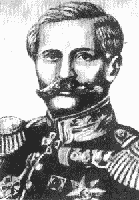 The XIX century was generally unusually fruitful for talented Russian rocket men. Among them, a significant place belongs to the adjutant general (according to other documents - the engineer-general) Karl Andreevich Schilder (1785-1854) [in the portrait on the left], the creator of the world's first missile submarine.
The XIX century was generally unusually fruitful for talented Russian rocket men. Among them, a significant place belongs to the adjutant general (according to other documents - the engineer-general) Karl Andreevich Schilder (1785-1854) [in the portrait on the left], the creator of the world's first missile submarine. Presenting this invention to the highest attention, he wrote: “Pursuing from 1832 onwards, looking for means of extracting possible benefits from the method of igniting gunpowder with electricity, I discovered the primary possibility of using this method in water. Guided by the methods of diving, I offered to arrange a metal boat. " There was permission to build it, but ... at the expense of the inventor. Built in May 1834 at the Alexander Plant on the Neva, the Schilder’s submarine with crew in 13 man could move in surface and submerged positions with the help of paddle-type duck paws brought in by two-way sailors who were stationed inside the boat hull. The boat was equipped with six sealed launch missile containers in the form of tubes mounted in an inclined position, three on each side. The missiles had a warhead with powder charges weighing from 4 to 16 kg. In addition, the bowsprit housed a powerful mine, delivered directly to the attacked ship. Missiles were launched and the mines were blown up with the help of electric fuses, activated by the command of the boat commander, who watched the target through a periscope.
Along the way, we can say that Schilder was considered the greatest specialist in his time in the mine-disruptive business.
The world's first underwater missile launch took place on the Neva River in 20 kilometers above St. Petersburg (just think!) During the life of A. Pushkin. Thus, there is every reason to believe that the creation of rocket submarines is the merit of Russian inventors. Therefore, it is impossible to agree with the statement of the West German magazine "Soldiers and Equipment", referring to 1960, that the first missile submarine was the German U-511 submarine, on the upper deck of which were installed tubes for launching 210 mm rockets. This boat was built more than a century after Schilder's boat.
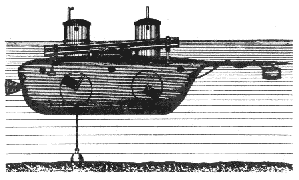 The disadvantage of the Schilder boat [in the picture on the right] was the low speed - about half a kilometer per hour. As a result, the Committee on underwater experiments recommended continuing exploration in order to increase the speed. But Nicholas I allowed this work to be carried out only by the “dependency of the inventor himself,” and Schilder had no money. And the world's first missile submarine was sold for scrap.
The disadvantage of the Schilder boat [in the picture on the right] was the low speed - about half a kilometer per hour. As a result, the Committee on underwater experiments recommended continuing exploration in order to increase the speed. But Nicholas I allowed this work to be carried out only by the “dependency of the inventor himself,” and Schilder had no money. And the world's first missile submarine was sold for scrap. The dramatic fate of the “secret vessel” involuntarily comes to mind - the wooden submarine built by the serf Yefim Nikonov (with the support of Peter the Great), capable of real diving. After the death of the king in 1725, the “secret vessel” was hidden “from enemy eyes” in a deaf barn, where it decayed.
Returning to the beginning of the XIX century, it should be noted that at that time the Military Scientific Committee was engaged in the problems of military rocket production. Considering the composition of rocket fuel as the main problem, the committee spent the period from 1810 to 1813. numerous studies in this area. The fuel composition of the British military missiles, stubbornly imposed on Russia, was studied with particular care. The analysis led to the conclusion that “there is nothing special in the composition, and these missiles are not any new, special composition, incendiary means, but merely an adaptation of the rapid strength of the missiles to long-distance transport of the usual incendiary composition without using heavy artillery to that ". After this conclusion, the committee’s attention shifted to the design of the missiles. As a result, it was found that "the strength of the aspirations of the rockets depends above all on the strict observance of perfect accuracy in the dimensions of the shells and tails."
Committee member Kartmazov succeeded in producing two types of military missiles in 1814: an incendiary 2960 m range and a grenade 1710 m range. W. Congreve, then considered the best in the world.
The colonel and then General William Congreve (1777 - 1828) belonged to the elite of the British armed forces. His interest in combat missiles, apparently, was associated with the aggression of England against India. In the battles of Seringapatam in 1792 and 1799. Hindus successfully used combat powder rockets with wooden tails against the invaders to stabilize the flight. Starting to develop their own designs in 1801, Kongrev achieved an increase in the range of 20-kilogram missiles to 2700 m and confident stabilization of their flight due to the central (and not the side, like the Indians) tail arrangement. Congreve missiles were effectively used by the British during the shelling of the French port of Boulogne from ships in 1806, during the siege of Copenhagen and in the battles of Gdansk and Leipzig. Congreve’s missiles were recognized as the best in the world and put into service in the armies of Denmark, Austria, Prussia, France and other states. In the Crimean War 1854 - 1856, the Anglo-French fleet bombarded Congreve with besieged Sevastopol. One of the objects of attack was the 4-I artillery battery near Malakhov Kurgan, commanded by Lieutenant Count L. Tolstoy.
Despite universal recognition and intimacy with the Russian emperor Nicholas I, whom he accompanied on a trip to England, Kongrev died at home in oblivion and poverty.
Congreve’s rockets were refined and significantly cheaper by the English designer Gel, who removed the stabilizing tail from them. The Americans first appreciated the merits of the Gel missiles and successfully used them in the war against Mexico. 18 August 1850 English merchant Nottingham offered the Russian government to sell for 30 thousand pounds sterling (189 thousand rubles at the then exchange rate) the secret of producing Gel rockets and instructions for their use. This was the second attempt by Nottingham, after 1848, to impose Russian military missiles on Russia. This time the proposal was accepted, but on the condition of experienced evidence of the practical advantages of these missiles in comparison with domestic ones. Soon in St. Petersburg, on the Volkov field, competitive firing of Geel and Konstantinov’s missiles took place. The advantage of Konstantinov’s missiles was so obvious that Nottingham’s proposal was rejected. In addition, domestic missiles and cost much cheaper - just three rubles each apiece. As a consolation prize, Nottingham was presented with a valuable gift, but the disgraced entrepreneur did not show due respect to the tsar's gift and, after a scandal, was expelled from Russia.
In 1842, the London-based firm Vede and Co offered the Russian government to buy from it a factory equipped for mass production of Congreve missiles. By order of the Russian authorities, this plant was examined by KI Konstantinov (then the captain) and reported to the Main Artillery Directorate of the Military Ministry that "there was nothing to learn from the British." Soon, a proposal was received from Germany to supply short-cut combat missiles to Russia, but they also rejected it.
By the middle of the 19th century, the ground forces, river and sea fleets of Russia were armed exclusively with domestic rocket weapons. At this time, it was especially successfully used in numerous wars that the Russian state led to repel foreign aggression and expand its limits, in particular, to conquer the Caucasus and Central Asia.
Domestic military rocket technology experienced a period of rapid flourishing in the 19th century. However, classical artillery, which was gaining strength, competed with it. There were rifled barrels of various calibers (up to 410 mm) and shells with belts and warheads with a powerful explosive, as well as high-precision fire control systems, including high-speed ones. All this dramatically increased the range and accuracy of artillery firing and the combat effect at the target. In addition, after the end of the Crimean War in 1856 and the conclusion of the Paris peace treaty, as well as the conquest of the Caucasus and Central Asia, the military department lost interest in missiles. All this led to the fact that in 1887, orders for the production and supply of military missiles to the Russian armed forces virtually ceased. In 1910, the giant rocket plant in Nikolaev was closed. By inertia, individual missiles were still produced at Shostka Powder Plant. It seemed that the rocket technology was over in Russia.
However, some enthusiasts were still working on improving the missiles. Thus, the teacher of the Artillery Academy, M. M. Pomortsev (1851 - 1916), achieves an increase of almost half the missile range a year before his death by improving the stabilization system. His missiles weighing up to 12 kg had a range of up to 8 km. At the same time, attempts Pomortseva replace powder with compressed air had no success. Military engineer N. V. Gerasimov at the same time, using a gyroscopic device, created a prototype of modern anti-aircraft guided missiles.
Despite the curtailment of the production of combat missiles in Russia, the end of the XIX - beginning of the XX centuries was marked by the appearance in our Fatherland of a large number of fundamental theoretical works on jet technology, which we describe in the chapter 4.
Rocket platoon Semirechensky Cossack troops, about 1891 g.
Alexander Shirokorad. The head of the "Konstantinov missile system" from the book "Domestic mortars and rocket artillery"
In 1842, Colonel K.I. Konstantinov (1818-1871), a member of the Marine Scientific Committee and the Military Scientific Committee, was appointed the head of the Rocket institution. By the way, Konstantinov was the illegitimate son of Grand Duke Konstantin Pavlovich from his connection with the singer Klara Anna Lawrence, that is, the nephew of Emperor Alexander III.
In 1847-1850, based on the device of a ballistic-gun gun mount, Konstantinov created a rocket electroballistic pendulum. This device allowed with sufficient accuracy for practice to measure the rocket thrust and determine the dependence of its magnitude on time. The creation of the rocket electric ballistic pendulum laid the foundations of the theory of ballistic missiles, without which the further development of jet weapons would be unthinkable. Calculated and empirically, Konstantinov managed to find the most advantageous combination of dimensions, shape, weight of missiles and powder charge to achieve the greatest range and correctness of the missile flight.
The following Konstantinov missiles were adopted by the Russian army: 2-, 2,5- and 4-inch (51-, 64- and 102-mm). Depending on the purpose and nature of the shooting, new names of the missiles were introduced - field and siege (serfs). Field missiles were armed with grenades and canister. Siege missiles were armed with grenades, canister, incendiary and lighting projectiles. The 2-and 2,5-inches belonged to the field missiles, and the 4-inches to the siege (fortress). The weight of the combat missiles depended on the type of warhead and was characterized by the following data: The 2-inch rocket weighed from 2,9 to 5 kg; 2,5 inches - from 6 to 14 kg and 4 inches - from 18,4 to 32 kg. (Figure XXX colored inserts)
In launchers (rocket launchers) Konstantinov used tubular guides. Moreover, the gap between the tube and the rocket was made less than in the English launchers, which improved the accuracy of fire. A single Konstantinov launcher consisted of a short iron pipe mounted on a wooden tripod. The angle of elevation of the pipe is usually given by the quadrant installed on the pipe. Horizontal guidance of the machine was carried out by direct sight of the pipe at the target. Starting machines were easy and convenient for people to carry and carry on horses. The maximum weight of the machine with the pipe reached 55-59 kg. (Fig. 84)
Figure 84. Konstantinov field rocket with a rocket
Konstantinov specially designed a lightweight launcher weighing about 1 pounds (16,4 kg) for mounted rocket teams. She easily and quickly clung to the horse.
The firing ranges of the Konstantinov system missiles he created in 1850-1853 were very significant at that time. Thus, the 4-inch rocket equipped with 10-pound (4,1 kg) grenades had a maximum range of 4150 m, and the 4-inch incendiary rocket had a 4260 m. For example, a quarter-mountain unicorn arr. 1838 g. Had a maximum range of only 1810 meters.
Konstantinov’s missiles differed little from their foreign counterparts in their weight-dimensional characteristics, but exceeded them in accuracy. Thus, comparative tests of the American (Gel system) and Russian missiles conducted in the summer of 1850 showed that the lateral deviation of the Russian missiles was no more than 30 steps (21 m), while American missiles had a lateral deviation up to 240 steps (171 m ).
In the period from 1845 to 1850, the Rocket institution produced combat missiles for experiments - 7225, for troops - 36187; incendiary rockets for experiments - 1107, for troops - 2300; high-explosive rockets for experiments - 1192; cartel missiles for troops - 1200. Total 49211.
In 1851 and 1852, the Missile Facility launched 2700 rockets per year, 1853, 4000 rockets, 1854, 10 488, 1855, 5870 rockets. At that time, only Konstantinov missiles were manufactured.
In May 1854 of the year at the request of the commander of the Southern Army A. S. Menshikov from the St. Petersburg Missile Facility 600 2-inch caliber combat missiles were sent to Sevastopol. With this batch of rockets, a lieutenant D. P. Shcherbachev, a fireworker and four privates, "acquainted with the action and use of combat missiles", were sent in an accelerated way of transportation. The convoy with rockets left St. Petersburg in May 1854, but only 1 arrived in Sevastopol in September of the same year.
10 missiles were launched against the enemy from the 4 th bastion. They did not cause serious damage to the enemy, and therefore the authorities turned the rocket team into a servant of the serfs, and the missiles were handed over to the warehouse.
In 1855, Lieutenant Colonel F.V. Pestich formed a mobile missile battery from sent missiles and launchers for them. The installations were placed on five troika half-corpses taken from a convoy of the Taturinsky regiment, and the battery was manned with twenty commanders from the flooded ships. For each installation identified 70 missiles. The remaining 250 rockets were transferred to the batteries of the Alexander and Konstantinovsky ravelins.
At the end of the defense of Sevastopol, Pestich proposed to install in the windows of the upper floors of the surviving buildings machines for launching rockets on the strategically important lines of attack of the allied forces. The first trial launches were made personally by Pestich from the windows of a new three-story barracks, adjacent to the naval hospital. The launches were very successful - when installing the elevation angles of 20 °, the rocket reached the front trenches. Rocket explosions occurred directly in enemy trenches, causing significant damage to manpower to the enemy. After some time, the enemy opened fire on the upper floors of the barracks.
10 August 1855, in the Revel area, a rocket volley was launched on the Allied ships. KI Konstantinov himself commanded rocket engineers. But there were no hits in the ships.
After the Russian-Turkish war of the 1828-1829, only one rocket company was part of the Russian artillery. In 1831, this company was renamed the rocket battery. Solid rocket battery had no. Throughout its existence until the beginning of the Crimean War, the composition and organization of the rocket battery was constantly changing. The approximate composition of the rocket battery for the 1831 year was as follows:
Officers (with battery commander) - 10 people.
Fireworks - 24 people.
Musicians - 3 pax
Gornistov - 3 people.
Privates (scorers, gunners and gantlangers) - 224 people.
Non-combatant various specialties - 99 people.
Total in the battery - 363 people.
The missile battery was armed with:
large six pipe machines
for 20-Pound Missiles - 6
single tube tripod machines
for 12-Pound Missiles - 6
single tube tripod machines
for 6-Pound Missiles - 6
Total machines - 18
The horses in the battery were supposed to have 178 in wartime, 58 in peacetime.
Konstantinov missiles were successfully used during the 1853-1856 war on the Danube, the Caucasus and Sevastopol. They showed high combat qualities against infantry and cavalry, as well as during the siege of fortresses, especially in the 1853 year when Akmechet was captured and in the 1854 year during the siege of Silistra. (Figure XXXI colored inserts)
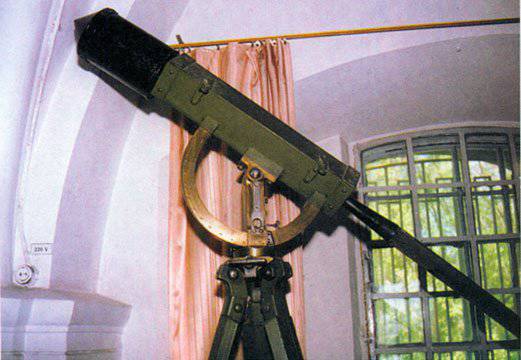
Xxx. Launcher and 2-inch Konstantinov rocket
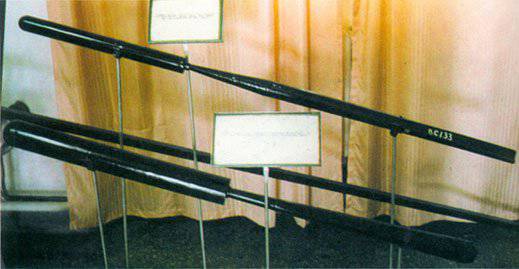
Xxxi. Konstantinov rocket during the Crimean War
An example of the successful use of missiles is the Battle of Kyuruk-Dara (Caucasus Campaign 1854 of the Year). The detachment of Prince Vasily Osipovich Bebutov as part of 18 thousands of bayonets and sabers attacked the 60-thousandth Turkish army. Russian artillery consisted of 44 foot and 20 cavalry guns and 16 rocket launchers, which were in service with the equestrian missile team. The report of the Chief of Artillery of the Separate Caucasian Corps of 7 in August 1854 of the year said: “Having cast fear of the enemy, the missiles with surprise and novelty of their use not only made a strong moral impression on his infantry and cavalry, but, being aptly directed, they caused real harm to the masses, especially during the chase. ”
Immediately after the end of the Crimean War, most of the rocket batteries and teams were disbanded. The last rocket battery was disbanded in April 1856, according to the highest command of Emperor Alexander II. However, there is no need to talk about the incompetence and reactionary nature of the king and his dignitaries, as many Soviet historians did. They did it quite funny - under the reactionary Nikolai Palkin, the missiles were in service with the Russian army, and under the liberal “Tsar-Liberator” they were completely eliminated. The point here is not in rockets, but in the appearance of rifled guns, which, with the same weight and size characteristics as those of smooth-bore guns, sharply increased accuracy and firing range. Needless to say, primitive missiles with huge stabilizers had a much smaller range, and most importantly, a huge spread.
Nevertheless, K. I. Konstantinov did not stop work on the improvement of missiles; he strongly promoted them in his speeches before the officers and in the press. At the cost of enormous efforts, Konstantinov succeeded in restoring the rocket unit in the form of a rocket half-battery in 1859, and to obtain permission to build a new rocket factory in the city of Nikolaev.
Experiments conducted from 1860 to 1862 year, with the help of rocket electroballistic pendulum Konstantinov was able to establish that the direction of flight of old-style rockets (1849 of the year) depends on the uneven burning of the "deaf", which is much thicker than the wall of the powder (main) composition of the ring. It was also found that if the “deaf train” was made the same length as the thickness of the ring of the main rocket train, then sharp deviations of the missile’s flight from a given trajectory could be avoided. This was achieved in the new model of the rocket, designed by Konstantinov in 1862 year.
The new rocket also had the form of a grenade, but was significantly different in its internal structure. First of all, the bursting charge chamber was reduced, due to which a gap was created from the refractory composition, with which it was isolated the bursting charge from the main rocket train. As a result of this, premature rocket ruptures on machine tools were eliminated. To this end, the shock battalion for launching missiles was also improved. It now consisted of a trigger and a new tube fire-tube design. An important improvement was the reduction of the value of the “blind composition” to the size of the wall thickness of the main rocket composition. Improvement of the "deaf" significantly improved the ballistic qualities of missiles. In particular, the speed of flight of rockets increased, their flight on the active branch of the trajectory became more stable. All this led to an increase in shooting accuracy and effectiveness of their actions.
Rockets arr. 1862 were produced in two calibers: for field artillery - 2-inch with a range of 1500 and for fortress and siege artillery - 4-inch with a range to 4200 m.
In 1868, KI Konstantinov created a new rocket launcher and new launchers, thanks to which the missile rate of fire increased to 6 rounds per minute. For designing a rocket machine for 2-inch rockets, the Academic Council of the Artillery Academy awarded the Konstantinov a large Mikhailov Prize in the 1870 year.
Unfortunately, after the death of K. I. Konstantinov in 1871, the rocket business in the Russian army fell into disrepair. Fighting missiles occasionally and in small quantities were used in the 1877-1878 Russian-Turkish war. More successfully, rockets were used to conquer Central Asia in the 70-80-s of the XIX century. This was due to their good mobility (rockets and machine tools were transported on packs), with a strong psychological effect on the natives and, last of all, with the absence of artillery from the enemy. The last time rockets were used in Turkestan in the 90-s of the XIX century. And in 1898, combat missiles were officially decommissioned by the Russian army.
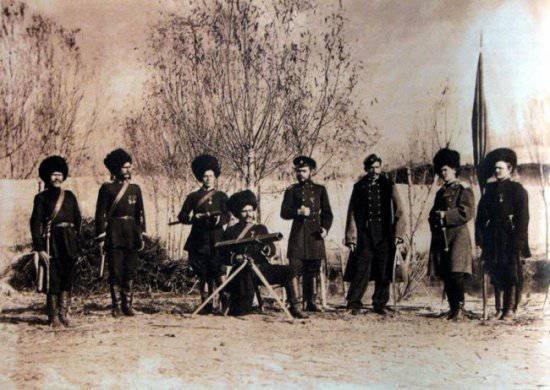
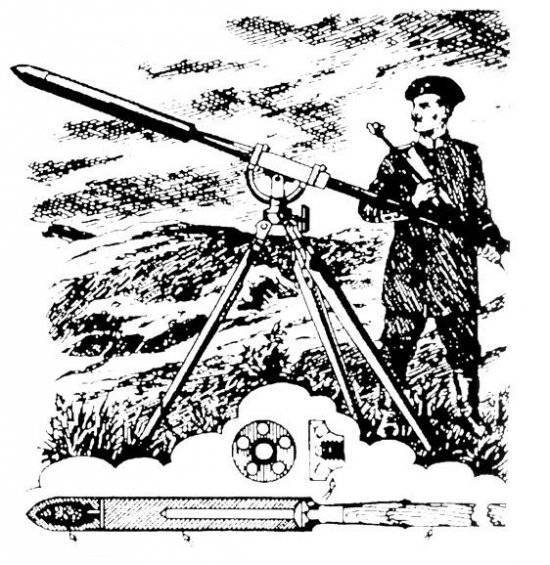
Information